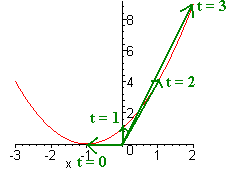| Vector Valued Functions Definition of a Vector Valued Function A vector valued function is a function where the domain is a subset of the real numbers and the range is a vector. In two dimensions r(t) = x(t)i + y(t)j In three dimensions r(t) = x(t)i + y(t)j + z(t)k You will notice the strong resemblance to parametric equations. In fact there is an equivalence between vector valued functions and parametric equations. Example r(t) = 3i + tj + (sin t) k To graph a vector valued function we can just graph the parametrically defined function Example Sketch the graph of r(t) = (t - 1)i + t2 j Solution We draw vectors for several values of t and connect the dots. Notice that the graph is the same as y = (x + 1)2  Limits We define the limit of a vector valued function by taking the limit of each of the components. Formally
Example Find the limit if sin t r(t) = et i + t Solution We take the three limits one at a time The first function is continuous at t = 0, so we can just plug in to get e0 = 1 For the second function, we get 0/0, so we use L'Hospital's rule to get cos t 1 Now plug in to get 1/1 = 1 For the kth component, we rewrite as ln t 1/t Now use L'Hospital's rule to get 1/t -1/t2 Plugging in 0 gives 0. Finally, gathering our results gives a limit of i + j We define continuity of vector valued functions in a similar way to how continuity of real valued functions was defined.
The practical way to investigate continuity is to look at each of the components. Example Determine where the following vector valued function is continuous. r(t) = ln(1 - t)i + 1/t j + 3t k Solution The first component is continuous for all values of t less than 1, the second component is continuous for t nonzero, and the third component is continuous for all real numbers. We can conclude that r(t) is continuous for all t less than 1 but not equal to 0. |
| |

No comments:
Post a Comment